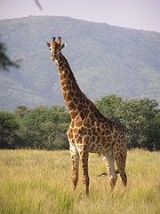
Giraffe
Overview
The giraffe is an African even-toed ungulate
mammal
, the tallest of all extant land-living animal species
, and the largest ruminant
. Its scientific name, which is similar to its archaic English name of camelopard, refers to its irregular patches of color on a light background, which bear a vague resemblance to a leopard
's spots, and its face, which is similar to that of a camel
. In addition to these features, the giraffe is noted for its extremely long neck and legs and prominent horns.
Even-toed ungulate
The even-toed ungulates are ungulates whose weight is borne about equally by the third and fourth toes, rather than mostly or entirely by the third as in odd-toed ungulates such as horses....
mammal
Mammal
Mammals are members of a class of air-breathing vertebrate animals characterised by the possession of endothermy, hair, three middle ear bones, and mammary glands functional in mothers with young...
, the tallest of all extant land-living animal species
Species
In biology, a species is one of the basic units of biological classification and a taxonomic rank. A species is often defined as a group of organisms capable of interbreeding and producing fertile offspring. While in many cases this definition is adequate, more precise or differing measures are...
, and the largest ruminant
Ruminant
A ruminant is a mammal of the order Artiodactyla that digests plant-based food by initially softening it within the animal's first compartment of the stomach, principally through bacterial actions, then regurgitating the semi-digested mass, now known as cud, and chewing it again...
. Its scientific name, which is similar to its archaic English name of camelopard, refers to its irregular patches of color on a light background, which bear a vague resemblance to a leopard
Leopard
The leopard , Panthera pardus, is a member of the Felidae family and the smallest of the four "big cats" in the genus Panthera, the other three being the tiger, lion, and jaguar. The leopard was once distributed across eastern and southern Asia and Africa, from Siberia to South Africa, but its...
's spots, and its face, which is similar to that of a camel
Camel
A camel is an even-toed ungulate within the genus Camelus, bearing distinctive fatty deposits known as humps on its back. There are two species of camels: the dromedary or Arabian camel has a single hump, and the bactrian has two humps. Dromedaries are native to the dry desert areas of West Asia,...
. In addition to these features, the giraffe is noted for its extremely long neck and legs and prominent horns.
Unanswered Questions
Discussions

